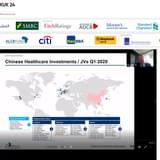At the end of 2015 and throughout 2016, concerns over the potential for a rapid economic slowdown in China have grown. Although a hard landing yet to materialise – according to the occasionally opaque National Bureau of Statistics of China, Chinese economic growth has remained at a steady 6.7% since January this year – Chang Liu, China Economist at Capital Economics noted that medium-term economic growth will be determined by the government’s ability and willingness to tackle the country’s structural problems, which includes how state owned enterprises are structured and run.
With the aim of boosting the country’s economic growth, the Chinese government is looking to restructure a number of SOEs through a reform programme aimed at increasing such entities’ competitiveness against other foreign companies.
In September, the government launched a CNY350bn (circa US$51bn) state enterprise restructuring fund. The reforms will at first affect SOEs operating in the energy, transport and telecoms industries amongst others. China Eastern Airlines Group, Unicom Group, China Southern Power Grid, Harbin Electric Corporation, China Nuclear E&C Group and China State Shipbuilding Corporation are all set to be involved in mixed-ownership reforms.
Liu noted that one of the key problems with SOEs is that many sectors they play in suffer from overcapacity, leading many firms run unprofitably.
A senior portfolio manager noted that it has be made clear that [the restructuring of SOEs] is not a major policy agenda rather than ongoing effort to address overcapacity concerns and inefficiency in the public sector, which still dominates the economy.
The government is trying to address this to some degree. It is looking to reduce the number of SOEs from 106 at present to fewer than 100 this year, according to Chinese state media.
The large number of SOEs does not only impact the sector’s performance, and the amount of Chinese SOEs has repercussions for the rest of the country’s economy.
“The extent of government support (both implicit and explicit) provided to state-owned firms causes many inefficiencies in the economy. For example, the financial system directs a disproportionate amount of resources to SOEs because they are perceived as lower credit risks. This diverts funds away from more productive parts of the economy and increases financial risks,” Liu said.
Starving other, more productive areas of the economy of funds means that unless significant reforms are implemented at SOEs, trend growth could fall to as low as 2% going forward. Capital Economics’ current estimate is between 4.5% and 5% trend growth.
The restructuring within the SOE sector, whilst not specifically designed to attract foreign investment, comes as part of the government’s broader financial sector reforms, part of which included the opening up of the country’s interbank bond market to foreign financial institutions earlier this year.
Nevertheless, by improving the health of the domestic economy through restructuring SOEs and by opening the financial markets, there will be an increase of capital inflows into the country. Achieving this goal is not without its difficulties, and in practice, reforms are likely to prove difficult to implement.
“The government will need to overcome the politically power-vested interests in the SOE sector. There are also concerns about the immediate economic fallout of any restructuring, including the rise in lay-offs and SOE defaults or closures,” Liu concluded.
He added that state-sector reforms in the late 1990s resulted in around 60,000 firms closing and 40 million workers losing their jobs. That said, the process is likely to be conducted over a long period of time.
“Going forward, I would expect to see more consolidation and measures to increase efficiency applied to local government-controlled companies rather than those controlled by the central government. However, the process is going to be gradual as it will be mindful about the social impact and destabilisation,” the portfolio manager noted.









